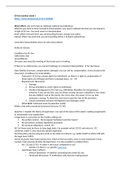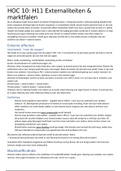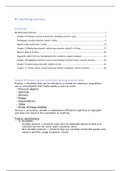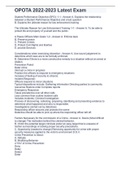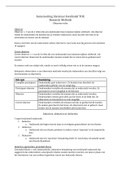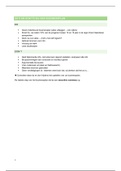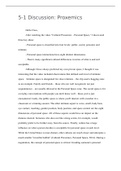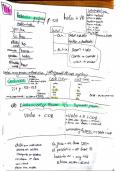A. Costov
Constitutions Compared - Summary
Constitutions Compared: Notes
Chapter 2 (week 1)
UK: principle of legislative supremacy – the Parliament and not the monarch is the sovereign; when
they make a law, they (formally) act together and this law – a statute – is the highest law in the UK.
Only another statute can overrule it
Part 1:
The authority of a constitution derives from the authority of the sovereign: the original source of all
public power from which all other powers flow; the ultimate power to exercise authority over oneself
Popular sovereignty – the majority of constitutions derive their authority from having been enacted by
people
Sovereignty: external and internal
- External sovereignty – the possibility for a state to exercise control over its territory and
population without foreign interference – fundamental concept of public international law
which originated after the Peace of Westphalia
- Internal sovereignty – internal sovereign is the original source of public authority within the
state
1.1
Royal sovereignty – derives its validity from the authority of a monarch (even if the monarch grants
people with a constitution which he can repeal at any moment)
1.1.2
Popular sovereignty – sovereignty of the people (US, Germany, France)
- People can exercise their will through (e.g.) a referendum
National sovereignty – sovereignty of the nation (more abstract because can sometimes not coincide
with the current population)
- People can only exercise their will through national representatives accordingly with the
constitution
1.1.5 The absence of sovereignty
In the NL constitution there is no indication about the notion of sovereignty: constitutional monarchy
with parliamentary system which is governed by the rule of law
1.1.6 EU
EU is not a state but it also isn’t merely an international organization where member states decide a
new legal order + states having transferred parts of their sovereignty
1.2 Parliamentary and Presidential systems
1
,A. Costov
Constitutions Compared - Summary
The important feature is whether the president is elected with a mandate of his own, or whether he
owes the continuation of his office to parliament and is responsible to the parliament
- US: both chambers of the parliament and the president have their own mandates president
is not accountable to the congress
- UK, NL, Germany: Prime minister/chancellor is not directly elected but enjoys confidence of
the Parliament and is accountable to it
Parliamentary confidence – if the parliament loses confidence the authority has to resign without a
trial or proof similar in all parliamentary systems in the world
In parliamentary systems Prime Ministers tend to have more powers than presidents (in presidential).
Yet, parliaments in presidential system are more independent, and the President doesn’t have as much
power as the Prime Minister legislation-wise
Semi-presidential system: both a directly elected president with many executive functions and a Prime
Minister who holds executive powers as well and is accountable to the Parliament
EU in many ways is a hybrid system as well: a lot of parliamentary features due to the important role
of the Parliament; also has presidential features because the President of the European Council is
appointed (not elected) and has a separate mandate from the MSs
1.3 Separation of Power, and Checks and Balances
Functional separation: legislative – makes laws, executive – enforces laws, judicial – interprets and
applies laws in the case of a conflict
Institutional separation: these three functions should be allocated with different organs
Personal separation: these three functions should be staffed by different people
Separation depends per state; however, the three branches never act in total isolation system of
checks and balances to prevent abuse by public authorities
Executive and legislative interact more; important that the judiciary is kept separate and independent.
EU: lawmaking procedure calls for 3 EU institutions + MSs who check and consult prevents abuse
of power; Commission + Council + MSs executive.
1.4 Role of judges
Constitutional review: power of the judge to check whether newly enacted laws are compatible with
the constitution
- US – allowed due to supremacy of the constitution
- Germany – only constitutional courts are allowed
- UK, NL – not allowed
1.5 Unitarism and Federalism
Federation – consists of territorial sub-units whose privileges are enshrined in the constitution itself
Unitary state – territorial sub-units receive their power from the central authority
2
, A. Costov
Constitutions Compared - Summary
1.6 Rule of law
Article 2 TEU
Contains 5 elements under German theory:
- Separation of power
- Binding nature of the constitution
- Binding nature of the law
- Ban on retroactivity and legal certainty
- Judicial review
Dutch: + protection of human rights
2. USA
Constitution:
- President (executive): head of state and head of federal executive; elected by indirect popular
vote and is chosen by electoral college whose members are elected within individual states
- Congress (legislative): bicameral – house of representatives (elected within each state) and
the senate(composed from 2 senators from each state)
- US Supreme Court (judiciary): highest court
Interact with each other through the system of checks and balances
- Congress adopts federal laws – president can veto them – veto can be overridden by 2/3 of the
members of the congress
- President has an independent electoral mandate – but congress can impeach him from the
office in the case of commission of serious crimes
- Judiciary can review laws against the constitution
3. Germany
- 1871 – The Prussian Empire
- 1918 – The Weimar Republic: elected president; governed by a chancellor directly
accountable to the parliament
- 1933-1945 – Dictatorship
- 1949 – GDR and FRG
- 1990 – FRG (united) with FRG’s Basic Law (modified) as a constitution
Federal republic comprising 16 states; federal government led by Federal Chancellor is elected and
accountable to Bundestag (directly elected federal parliament); Bundesrat – members of the
governments of the States; federal president is elected by Bundestag members and delegates from the
States
- Bundestag + Bundesrat = legislature
4. UK
1215 – Magna Carta – set of liberties (showed that the King was bound by law)
3
Constitutions Compared - Summary
Constitutions Compared: Notes
Chapter 2 (week 1)
UK: principle of legislative supremacy – the Parliament and not the monarch is the sovereign; when
they make a law, they (formally) act together and this law – a statute – is the highest law in the UK.
Only another statute can overrule it
Part 1:
The authority of a constitution derives from the authority of the sovereign: the original source of all
public power from which all other powers flow; the ultimate power to exercise authority over oneself
Popular sovereignty – the majority of constitutions derive their authority from having been enacted by
people
Sovereignty: external and internal
- External sovereignty – the possibility for a state to exercise control over its territory and
population without foreign interference – fundamental concept of public international law
which originated after the Peace of Westphalia
- Internal sovereignty – internal sovereign is the original source of public authority within the
state
1.1
Royal sovereignty – derives its validity from the authority of a monarch (even if the monarch grants
people with a constitution which he can repeal at any moment)
1.1.2
Popular sovereignty – sovereignty of the people (US, Germany, France)
- People can exercise their will through (e.g.) a referendum
National sovereignty – sovereignty of the nation (more abstract because can sometimes not coincide
with the current population)
- People can only exercise their will through national representatives accordingly with the
constitution
1.1.5 The absence of sovereignty
In the NL constitution there is no indication about the notion of sovereignty: constitutional monarchy
with parliamentary system which is governed by the rule of law
1.1.6 EU
EU is not a state but it also isn’t merely an international organization where member states decide a
new legal order + states having transferred parts of their sovereignty
1.2 Parliamentary and Presidential systems
1
,A. Costov
Constitutions Compared - Summary
The important feature is whether the president is elected with a mandate of his own, or whether he
owes the continuation of his office to parliament and is responsible to the parliament
- US: both chambers of the parliament and the president have their own mandates president
is not accountable to the congress
- UK, NL, Germany: Prime minister/chancellor is not directly elected but enjoys confidence of
the Parliament and is accountable to it
Parliamentary confidence – if the parliament loses confidence the authority has to resign without a
trial or proof similar in all parliamentary systems in the world
In parliamentary systems Prime Ministers tend to have more powers than presidents (in presidential).
Yet, parliaments in presidential system are more independent, and the President doesn’t have as much
power as the Prime Minister legislation-wise
Semi-presidential system: both a directly elected president with many executive functions and a Prime
Minister who holds executive powers as well and is accountable to the Parliament
EU in many ways is a hybrid system as well: a lot of parliamentary features due to the important role
of the Parliament; also has presidential features because the President of the European Council is
appointed (not elected) and has a separate mandate from the MSs
1.3 Separation of Power, and Checks and Balances
Functional separation: legislative – makes laws, executive – enforces laws, judicial – interprets and
applies laws in the case of a conflict
Institutional separation: these three functions should be allocated with different organs
Personal separation: these three functions should be staffed by different people
Separation depends per state; however, the three branches never act in total isolation system of
checks and balances to prevent abuse by public authorities
Executive and legislative interact more; important that the judiciary is kept separate and independent.
EU: lawmaking procedure calls for 3 EU institutions + MSs who check and consult prevents abuse
of power; Commission + Council + MSs executive.
1.4 Role of judges
Constitutional review: power of the judge to check whether newly enacted laws are compatible with
the constitution
- US – allowed due to supremacy of the constitution
- Germany – only constitutional courts are allowed
- UK, NL – not allowed
1.5 Unitarism and Federalism
Federation – consists of territorial sub-units whose privileges are enshrined in the constitution itself
Unitary state – territorial sub-units receive their power from the central authority
2
, A. Costov
Constitutions Compared - Summary
1.6 Rule of law
Article 2 TEU
Contains 5 elements under German theory:
- Separation of power
- Binding nature of the constitution
- Binding nature of the law
- Ban on retroactivity and legal certainty
- Judicial review
Dutch: + protection of human rights
2. USA
Constitution:
- President (executive): head of state and head of federal executive; elected by indirect popular
vote and is chosen by electoral college whose members are elected within individual states
- Congress (legislative): bicameral – house of representatives (elected within each state) and
the senate(composed from 2 senators from each state)
- US Supreme Court (judiciary): highest court
Interact with each other through the system of checks and balances
- Congress adopts federal laws – president can veto them – veto can be overridden by 2/3 of the
members of the congress
- President has an independent electoral mandate – but congress can impeach him from the
office in the case of commission of serious crimes
- Judiciary can review laws against the constitution
3. Germany
- 1871 – The Prussian Empire
- 1918 – The Weimar Republic: elected president; governed by a chancellor directly
accountable to the parliament
- 1933-1945 – Dictatorship
- 1949 – GDR and FRG
- 1990 – FRG (united) with FRG’s Basic Law (modified) as a constitution
Federal republic comprising 16 states; federal government led by Federal Chancellor is elected and
accountable to Bundestag (directly elected federal parliament); Bundesrat – members of the
governments of the States; federal president is elected by Bundestag members and delegates from the
States
- Bundestag + Bundesrat = legislature
4. UK
1215 – Magna Carta – set of liberties (showed that the King was bound by law)
3


